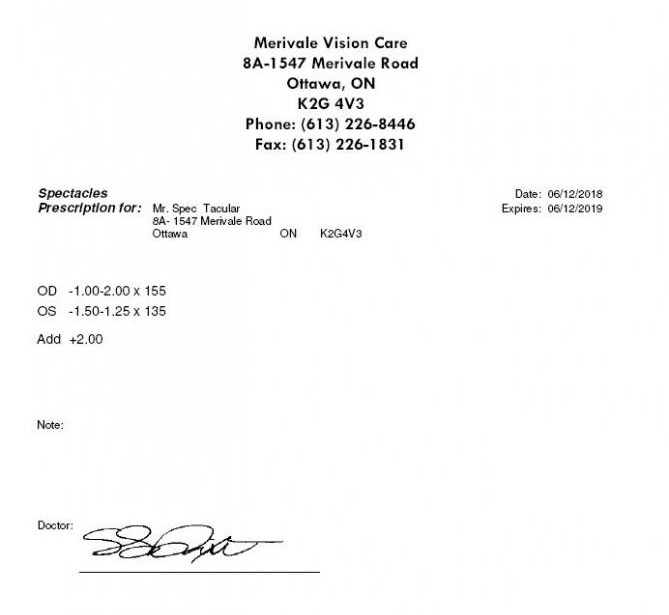Last Updated: March 18, 2023

Photo: Example prescription
Breaking down your prescription elements
Each optometrist will have their own format for writing a prescription so yours may not look exactly like the one pictured, but all the same information should be there, beginning with your name.
The first abbreviations you will notice are the letters OD and OS. These are derived from Latin for Oculus Dexter (OD) for right eye and Oculus Sinister (OS) for left eye. Occasionally, there may be the abbreviation OU, oculus uterque, for both eyes.
Next up, the numbers. The first number in a prescription is the spherical correction, often abbreviated as SPH. This is a measure (in dioptres) of how powerful the lens needs to be to correct either nearsightedness (noted with a - ) or farsightedness (noted with a + ). The second number is the cylindrical correction. This will only be on a prescription if you have astigmatism. If you do have astigmatism, it requires what is referred to as a cylindrical correction, another term provided on the written prescription. It is not uncommon for the numbers for the right eye to be quite different to the number for the left eye; in fact this is the norm.
If you require a different prescription for near vision, this can be noted in two ways: another full listing of SPH, CYL, AXIS or a correction factor called ADD, which refers to the distance a prescription should be changed to achieve the near prescription.
A small percentage of prescriptions incorporate prism as a way to aid the eyes working together, or to assist in rehabilitation. This number is measured in prism dioptres, or PD, and would be followed by the direction of the base or thickest edge of the prism: BU= base up, BD=base down, BI=base in (toward the nose), and BO=base out (toward the ear).
PD also stands for interpupillary distance, the distance from the centre of one eye to the centre of the other eye when measured with the eyes gazing to the distance the prescription was intended for. This may or may not be included on your written prescription.
There may be other notes on your prescription related to lens design or coatings that your optometrist has specifically recommended to give you the most comfortable vision correction possible.
In short, prescriptions provide the information that will be used to correct what is causing your vision to be blurred or strained. Called a refractive error, glasses or contact lenses correct for this defocus. That’s it! You can now read your own prescription, and understand what it reveals about your vision.